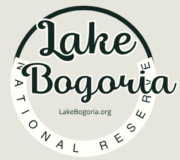A Month-by-Month Breakdown for Travelers
Lake Bogoria National Reserve is located in Kenya’s Great Rift Valley, within Baringo County. Its semi-arid climate, geothermal activity, and seasonal weather shifts all contribute to a uniquely dynamic environment that influences wildlife behavior, road conditions, and overall visitor experience. This guide offers a detailed month-by-month breakdown of Lake Bogoria’s weather and climate to help you plan the ideal trip.
🌍 General Climate Overview
- Altitude: 975–1,250 meters (3,200–4,100 feet) above sea level
- Climate Type: Semi-arid with two rainy seasons
- Temperature Range:
- Daytime: 25°C to 35°C (77°F – 95°F)
- Nighttime: 12°C to 20°C (54°F – 68°F)
- Rainy Seasons:
- Long rains: March to May
- Short rains: November to early December
- Dry Seasons: January–February, June–October
Temperatures in Lake Bogoria NR
Visitors to Lake Bogoria National Reserve can expect a semi-arid climate characterized by hot daytime temperatures and cooler nights year-round. Daytime temperatures typically range between 25°C and 35°C (77°F to 95°F), especially during the dry season from January to March and again from June to October, when skies are clear and solar radiation is intense.
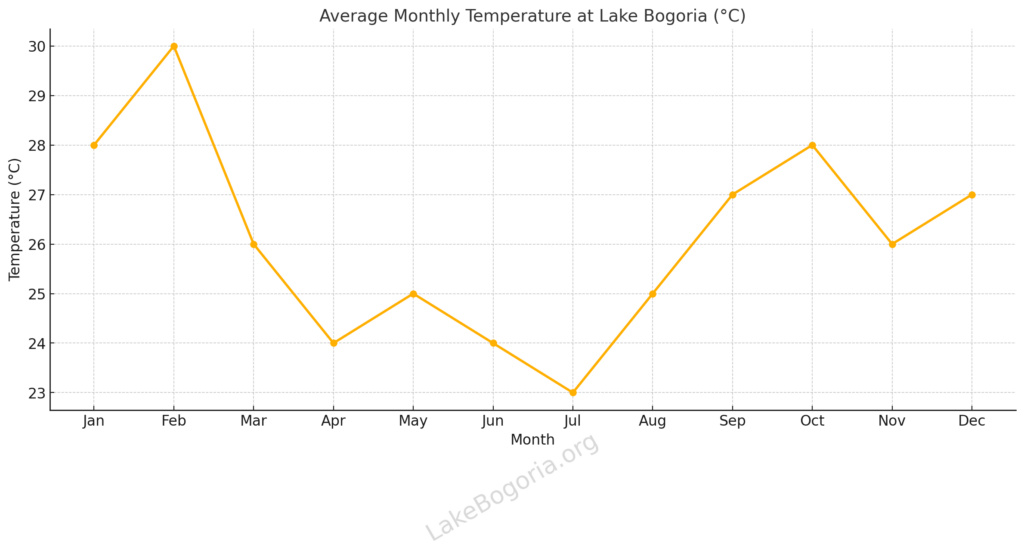
Nights are significantly cooler, often dropping to around 12°C to 18°C (54°F to 64°F), particularly between June and August. The reserve’s low elevation and open terrain amplify heat during midday hours, making early morning and late afternoon the most comfortable times for wildlife viewing and exploration. Visitors should dress in light, breathable clothing for the day but carry warm layers for chilly mornings and evenings.
Rainfall in Lake Bogoria NR
Lake Bogoria National Reserve experiences a semi-arid climate with distinct rainfall patterns that visitors should consider when planning their trip. The area receives mean annual precipitation ranging from 500 mm to 1,000 mm, primarily during two rainy seasons: April to May and October to November. April typically stands out as the wettest month, with average rainfall reaching up to 5.4 inches (137 mm).
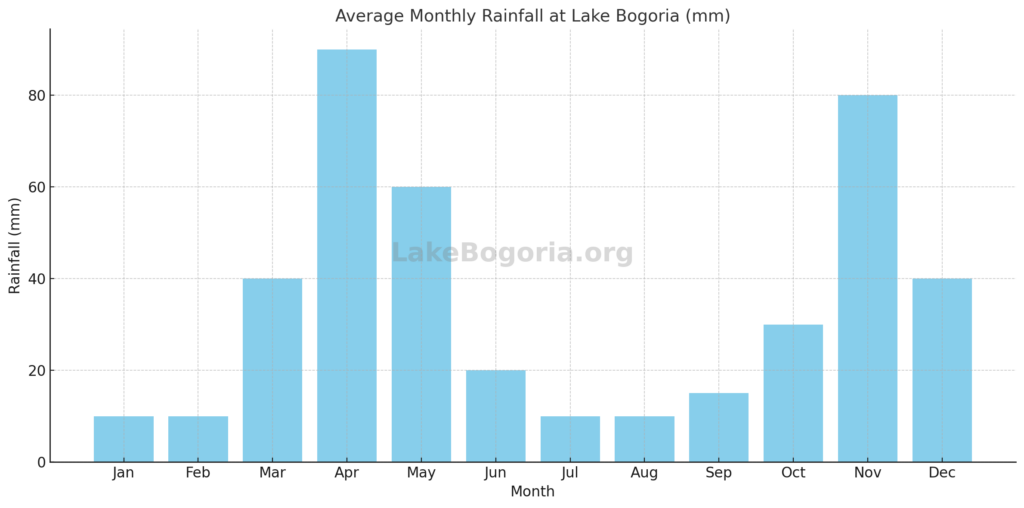
Conversely, the driest months are January and February, averaging about 0.7 inches (18 mm) of rainfall. While rain showers during the wet seasons are often brief and occur in the afternoons, they can influence travel plans and wildlife viewing. Therefore, visitors should prepare for potential rain during these periods and consider scheduling activities during the drier months for optimal conditions.
Climate in Lake Bogoria Reserve:
Lake Bogoria National Reserve has a semi-arid to arid climate, shaped by its location within Kenya’s Great Rift Valley and its relatively low elevation. Visitors can expect hot, dry conditions for most of the year, with average daytime temperatures ranging from 25°C to 35°C (77°F to 95°F), particularly during the dry seasons from January to March and June to October. Nights are cooler, with temperatures often dropping to 12°C to 18°C (54°F to 64°F), especially during the mid-year months.
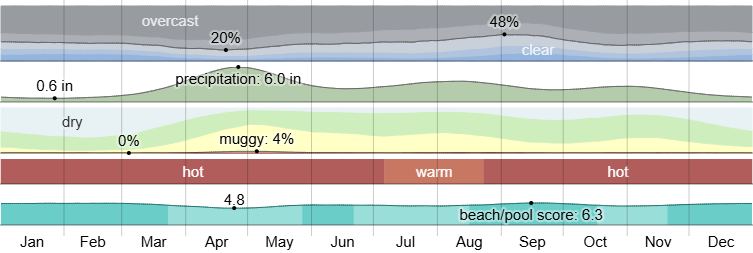
Rainfall is highly seasonal and unpredictable, typically occurring in two brief rainy seasons—March to May (long rains) and October to November (short rains). Despite the arid setting, these rains can transform the landscape into lush greenery, though they may also render some access roads muddy and difficult to navigate.
Overall, Lake Bogoria’s climate is ideal for wildlife viewing and photography, especially in the cool, dry months between July and September, when flamingo populations peak and the skies are consistently clear.
🗓️ Month-by-Month Weather Guide
January
- Weather: Hot and dry
- Avg. Temp: 28°C (82°F)
- Rainfall: Minimal
- Humidity: Low
- Conditions: Sunny, dusty roads, very good for hiking and photography
✔️ Great for birdwatching and fewer tourists
❗ Stay hydrated and use sun protection
February
- Weather: Hot and dry with occasional afternoon heat haze
- Avg. Temp: 30°C (86°F)
- Rainfall: Low
- Conditions: Dry vegetation, excellent visibility for wildlife spotting
✔️ Best for camping and game viewing
❗ Early starts recommended due to midday heat
March
- Weather: Start of long rains
- Avg. Temp: 26°C (79°F)
- Rainfall: Moderate to increasing
- Conditions: Intermittent showers, especially in the afternoons
✔️ Lush landscapes begin forming
❗ Roads can become muddy; 4×4 required
April
- Weather: Peak of long rains
- Avg. Temp: 24°C (75°F)
- Rainfall: High
- Conditions: Cloudy, slippery tracks, vibrant green surroundings
✔️ Unique photography opportunities
❗ Least accessible month—plan with caution
May
- Weather: Rain starts to subside
- Avg. Temp: 25°C (77°F)
- Rainfall: Decreasing but still present
- Conditions: Mixed days of sunshine and showers
✔️ Beautiful post-rain scenery, fewer crowds
❗ Flamingo numbers still low, roads still drying
June
- Weather: Dry season begins
- Avg. Temp: 24°C (75°F) with cooler mornings
- Rainfall: Low
- Conditions: Clear skies, dry trails, fresh vegetation
✔️ Excellent for hiking, hot spring visits, and flamingo return
❗ Pack warm layers for early mornings
July
- Weather: Cool and dry
- Avg. Temp: 23°C (73°F)
- Rainfall: Very low
- Conditions: Clear, calm weather; great for sunrise photography
✔️ Start of flamingo peak season
❗ Mornings can be chilly—bring a jacket
August
- Weather: Dry and sunny
- Avg. Temp: 25°C (77°F)
- Rainfall: Minimal
- Conditions: Excellent road access, great air clarity
✔️ Best month for flamingos, wildlife viewing, and photography
❗ Reserve accommodation early—it’s peak season
September
- Weather: Dry with slight warming
- Avg. Temp: 27°C (81°F)
- Rainfall: Low to negligible
- Conditions: Hot afternoons, cool nights
✔️ Fantastic for birding, flamingos still present
❗ Carry water and sun protection for daytime hikes
October
- Weather: Transition month
- Avg. Temp: 28°C (82°F)
- Rainfall: Increases slightly toward end of month
- Conditions: Clear mornings, possible late afternoon showers
✔️ Still dry enough for activities, fewer crowds
❗ Plan outdoor activities early in the day
November
- Weather: Short rains begin
- Avg. Temp: 26°C (79°F)
- Rainfall: Moderate to high
- Conditions: Unpredictable showers, some flooding in low-lying areas
✔️ Moody skies perfect for landscape photography
❗ Prepare for sudden weather changes and slippery roads
December
- Weather: Rains taper off by mid-month
- Avg. Temp: 27°C (81°F)
- Rainfall: Decreasing
- Conditions: Mix of sunny days and occasional light showers
✔️ Great post-rain greenery, bird activity increases
❗ Book early for holidays; some roads may still be wet
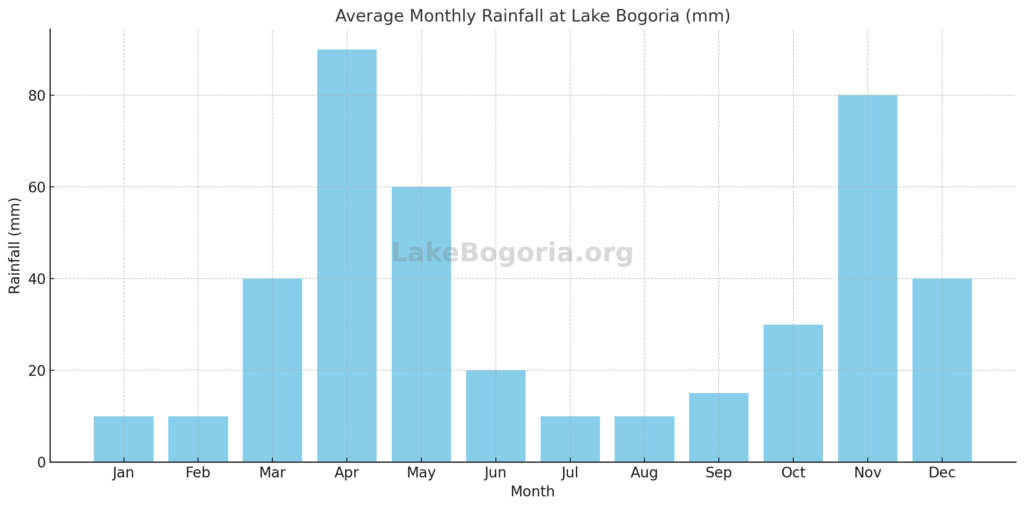
🌡️ Summary Table: Lake Bogoria Climate Overview
| Month | Temp (°C) | Rainfall | Season | Notes |
|---|---|---|---|---|
| January | 28 | Low | Dry | Hot, clear skies |
| February | 30 | Low | Dry | Warmest month |
| March | 26 | Increasing | Start of Long Rains | Variable weather, greener landscape |
| April | 24 | High | Wet | Difficult travel, very lush |
| May | 25 | Moderate | Wet | Rain easing, quieter period |
| June | 24 | Low | Start of Dry Season | Excellent for activities, flamingos return |
| July | 23 | Very Low | Dry | Cool mornings, great visibility |
| August | 25 | Very Low | Dry | Peak wildlife & flamingos |
| September | 27 | Low | Dry | Hotter days, fewer tourists |
| October | 28 | Rising | Transition | Flamingos remain, weather change begins |
| November | 26 | High | Short Rains | Wet conditions, variable visibility |
| December | 27 | Moderate | End of Short Rains | Post-rain greenery, increased activity |
🧭 Final Tips for Weather-Based Planning
- Best for Flamingos: July to October
- Best for Photography: June to September
- Best for Hiking & Camping: June to August
- Avoid Travel (if unprepared): April & early May
🌤️ No matter when you visit, come prepared with layered clothing, good footwear, and weather updates. Lake Bogoria’s raw beauty shifts with the seasons—and that’s part of its magic.
